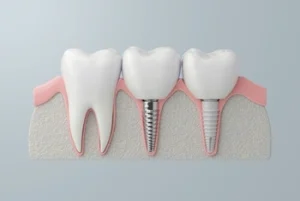If you’ve recently had dental implant treatment, it’s completely normal to feel some tenderness or discomfort as your mouth adjusts. Many patients ask how long soreness should last or what they can do at home to make things easier. While every person heals differently, a few simple steps can make a significant difference in your recovery. Think of this stage as your body’s way of adapting to the new tooth structure while gradually building stability beneath the surface. Want to know how to relieve pain from dental implant? Let’s go through what kind of discomfort is normal, what helps, and when it’s time to reach out for help from your dentist.
Understanding Why Dental Implant Pain Happens and When It’s Normal
Discomfort after dental implant surgery is part of the body’s natural adjustment. The area around the implant needs time to heal and integrate with the surrounding bone, which can cause sensitivity or pressure for a short period. Knowing what’s expected can help you stay calm and confident as you recover.
What Happens During the Dental Implant Procedure
 Before your new tooth can function like a natural one, the foundation must be placed securely within the bone. The tooth implant procedure may sound complex, but it’s actually carefully structured to support comfort and long-term strength. Your dentist begins by reviewing your oral health and planning the exact placement point using detailed imaging. These steps ensure that the treatment fits your bite and aligns well with surrounding structures. When the time comes for the procedure itself, you’ll receive local anaesthetic to keep you relaxed while your dentist performs the implant surgery with precision.
Before your new tooth can function like a natural one, the foundation must be placed securely within the bone. The tooth implant procedure may sound complex, but it’s actually carefully structured to support comfort and long-term strength. Your dentist begins by reviewing your oral health and planning the exact placement point using detailed imaging. These steps ensure that the treatment fits your bite and aligns well with surrounding structures. When the time comes for the procedure itself, you’ll receive local anaesthetic to keep you relaxed while your dentist performs the implant surgery with precision.
Step-by-Step Care During Oral Surgery: The process starts with a small opening made in the gum to expose the jaw bone. From there, the implant post is positioned gently into the prepared space, creating a stable foundation for the future crown. Each implant site is measured accurately, so the placement supports both function and balance. Once secured, the gum tissue is repositioned to protect the area as healing begins. Although this is considered an invasive procedure, advances in modern techniques allow patients to recover more comfortably than in years past. Most people find the experience manageable with appropriate care and guidance afterward.
The Body’s Natural Bond: How Healing Takes Place: What makes this stage unique is how the implant integrates with your bone during dental implant recovery. Over the following weeks, a natural process called osseointegration occurs, where the surrounding bone tissue fuses tightly with the titanium post. This is what gives implants their strength and stability. The dental implant recovery process varies slightly depending on your body’s healing rate, but most patients find the first few days are when tenderness is most noticeable. Mild swelling or bruising can appear around the dental implant site, but this is part of the body’s normal adjustment as it begins to heal.
Caring for the Area After Dental Surgery: Once initial tenderness eases, your dentist will monitor progress to ensure the implant is healing correctly within the bone. They’ll look for signs that your gum tissue and underlying bone are bonding as expected. This stage forms the foundation of successful dental implant placement, where long-term comfort depends on allowing the area to rest undisturbed. During this time, you may be asked to avoid hard or sticky foods, as they can irritate the surgical area or affect the blood clot forming at the site. Following these guidelines ensures the tissues stay protected while the implant settles securely.
From Surgery to Stability: The Journey to Comfort: Dental surgery of this kind is more advanced than many other tooth replacement options, but the healing process is usually predictable when proper care is followed. Most discomfort can be managed with simple measures like warm salt water rinses and gentle brushing near the area. Within a few days, pain typically subsides as the tissues stabilise and the gum begins to look healthy again. When healing continues without interruption, the result is a strong, natural foundation ready for the final crown. Although it requires patience, the outcome is worth it, a reliable replacement that feels stable and functions comfortably, as if it had always been part of your mouth.
What Causes Pain After Implant Placement
After any surgical procedure, your body begins a healing process that involves mild inflammation and tissue regeneration. During the dental implant procedure, your dentist carefully positions the titanium post into the jaw bone to replace missing teeth. This triggers the body’s healing process, creating new bone around the implant site. Mild discomfort usually peaks within the first few days and fades as healing progresses. Keeping the area clean and following your treatment plan supports faster healing.
When Mild Discomfort Becomes a Concern
While soreness after implant surgery is expected, severe pain that continues beyond a few days might signal a problem. Pain accompanied by swelling, bleeding, or heat around the implant site could suggest post-operative complications. It’s important to contact your dentist immediately if pain increases instead of easing. Early assessment prevents further irritation and supports a smooth recovery.
How Your Body Adjusts During the Recovery Period
Most patients notice gradual improvement as their body’s healing process strengthens the connection between the implant and bone. Eating soft foods during this time helps avoid putting pressure on the surgical site. The surrounding tissues adapt slowly, and the healing properly ensures the implant remains stable. Consistency with gentle oral hygiene practices and adequate rest gives your body time to settle comfortably.
Signs That Healing Is on Track
A successful recovery involves steady progress. Any lingering sensitivity should decrease daily, and the implant area should look calm without redness or discharge. Regular dental check-ups help your dentist confirm that the implant is integrating correctly. Following dental implant aftercare tips like avoiding hot foods, maintaining oral hygiene, and keeping the area clean will support optimal healing.
Simple Relief Steps You Can Use at Home for Comfort
Even with a straightforward dental implant process, it’s common to feel tender for a few days. The good news is that simple at-home steps often bring quick comfort. Paying attention to your mouth’s signals helps you manage pain before it disrupts your routine.
Practical Pain Relief Techniques
Pain relief after a surgical procedure starts with following your dentist’s advice. Over-the-counter medication can help manage pain as the anaesthetic wears off, but always follow the dosage recommended by your dental professional. Gentle rinses during recovery help soothe the surgical area and reduce swelling naturally. A soft-bristled toothbrush keeps the gums and surrounding teeth clean without disturbing the implant site.
Eating for a Smoother Recovery
Your diet plays a crucial role in recovery. A soft food diet allows the implant site to heal without added strain. Opt for nourishing options that don’t stress the implant area, such as yoghurt, mashed vegetables, and soups. Avoid crunchy foods or anything that can irritate the area around the implant. Sticking to nutritious meals with plenty of fluids supports the body’s healing process and encourages a faster healing process.
Gentle Oral Care That Promotes Healing
Gentle oral hygiene is key to preventing infection. Use gentle oral hygiene practices such as rinsing lightly and avoiding the surgical area for the first few days. Once cleared by your dentist, keep your mouth clean with care, focusing on comfort rather than pressure. Clean around the implant with slow, light movements to avoid irritation. Maintain regular cleaning habits, but move softly to protect the gums.
When Professional Care Is Needed to Manage Implant Pain
Even with diligent home care, there are times when professional attention is necessary. Understanding when discomfort is a normal part of recovery and when it might point to a concern is essential for your overall dental health.
Knowing When to Call Your Dentist
If you experience severe pain, swelling, or persistent throbbing around the implant site, don’t wait to see if it improves. Call your dentist immediately. These signs might indicate infection or irritation beneath the gum line. Early evaluation allows your dentist to identify the cause and begin effective pain management before the issue progresses.
 Addressing Possible Complications Early
Addressing Possible Complications Early
Occasionally, complications such as dental implant failure or nerve damage can arise. These are uncommon but require prompt attention. Your dentist may assess the implant site using X-rays to confirm that it’s healing properly. In rare cases, irritation in the surrounding bone or tissues can delay healing. Identifying these concerns early allows your dental professional to adjust your treatment plan for a successful recovery.
How Dentists Manage Ongoing Discomfort
If discomfort persists after the initial healing period, your dentist may review the fit and stability of the implant. Adjustments to the crown or surrounding teeth may relieve pressure and improve comfort. In some cases, additional care like cleaning the implant surface or prescribing medication can ease inflammation. Following regular dental check-ups helps detect subtle changes before they become larger issues.
Keeping Your Dental Implant Comfortable in the Long Run
Once your mouth has healed, the focus shifts to maintenance and prevention. Good oral hygiene and consistent care make all the difference in keeping your implant healthy and comfortable for years.
Building Long-Term Comfort Through Care
A healthy implant depends on the same habits that protect natural teeth. Brushing twice daily with a soft-bristled toothbrush removes bacteria without irritating the gum line. Flossing gently around the implant prevents food from collecting near the base. Occasional rinses with mild saltwater or an antiseptic mouthwash can support gum comfort and reduce irritation. These habits significantly contribute to a smooth recovery and ongoing comfort.
Avoiding Common Mistakes That Delay Healing
Some habits can interfere with your recovery. Smoking, skipping cleaning, or eating hard foods during the early stages can delay healing. Be mindful not to strain the implant area while eating or cleaning, especially during the first few weeks after placement. Following your dentist’s advice about gentle care and choosing meals that are gentle on your mouth while you recover supports stable healing. Remember that a healthy diet and adequate sleep also promote strong gum tissue and long-lasting results.
The Role of Professional Maintenance
Even after healing, implants need regular care. Visiting your dentist for regular dental check-ups allows early detection of any inflammation or plaque around the implant area. Professional cleaning protects both the surrounding bone and gum health. These visits help maintain your oral health and prevent potential implant failure. Modern dentistry offers precise cleaning tools that protect the implant surface without causing damage.
 Understanding How Implants Integrate With the Jaw
Understanding How Implants Integrate With the Jaw
Dental implants fuse with the jaw bone through a biological process called osseointegration. Once this connection forms, the implant acts as a stable foundation for the crown. Maintaining this bond depends on a balance of clean habits and ongoing reviews with your dentist. Any inflammation or pressure on the surrounding tissues can affect stability, so gentle brushing and good oral hygiene are essential.
When Reassurance Matters Most
Even years after placement, it’s natural to feel uncertain about mild sensations near your implant. Small changes can occur as your gums adapt, but persistent discomfort should always be discussed with your dentist. Managing discomfort early ensures that your dental implant treatment remains stable. If cared for properly, implants can function comfortably for decades.
Finding Relief and Protecting Long-Term Comfort
Dental implant pain can be managed effectively when you know what to expect and act early on any unusual changes. From following post-surgery instructions to maintaining oral hygiene and sticking to gentle routines, every step you take supports your body’s recovery. Choosing easy-to-chew foods, staying hydrated, and resting well all contribute to a smoother healing process. Professional guidance ensures that your implant site heals correctly and stays stable for years to come.
If you experience pain that doesn’t ease or have questions about your recovery process, contact our team for personalised advice. Call us today on (02) 9054 5281 to book a review appointment and ensure your healing is on track for a healthy smile and successful recovery.
Note: Any surgical or invasive procedure carries risks. Before proceeding, you should seek a second opinion from an appropriately qualified health practitioner.
References
https://www.fda.gov/medical-devices/dental-devices/dental-implants-what-you-should-know
https://jada.ada.org/article/S0002-8177(14)60300-7/fulltext


 Addressing Possible Complications Early
Addressing Possible Complications Early Understanding How Implants Integrate With the Jaw
Understanding How Implants Integrate With the Jaw